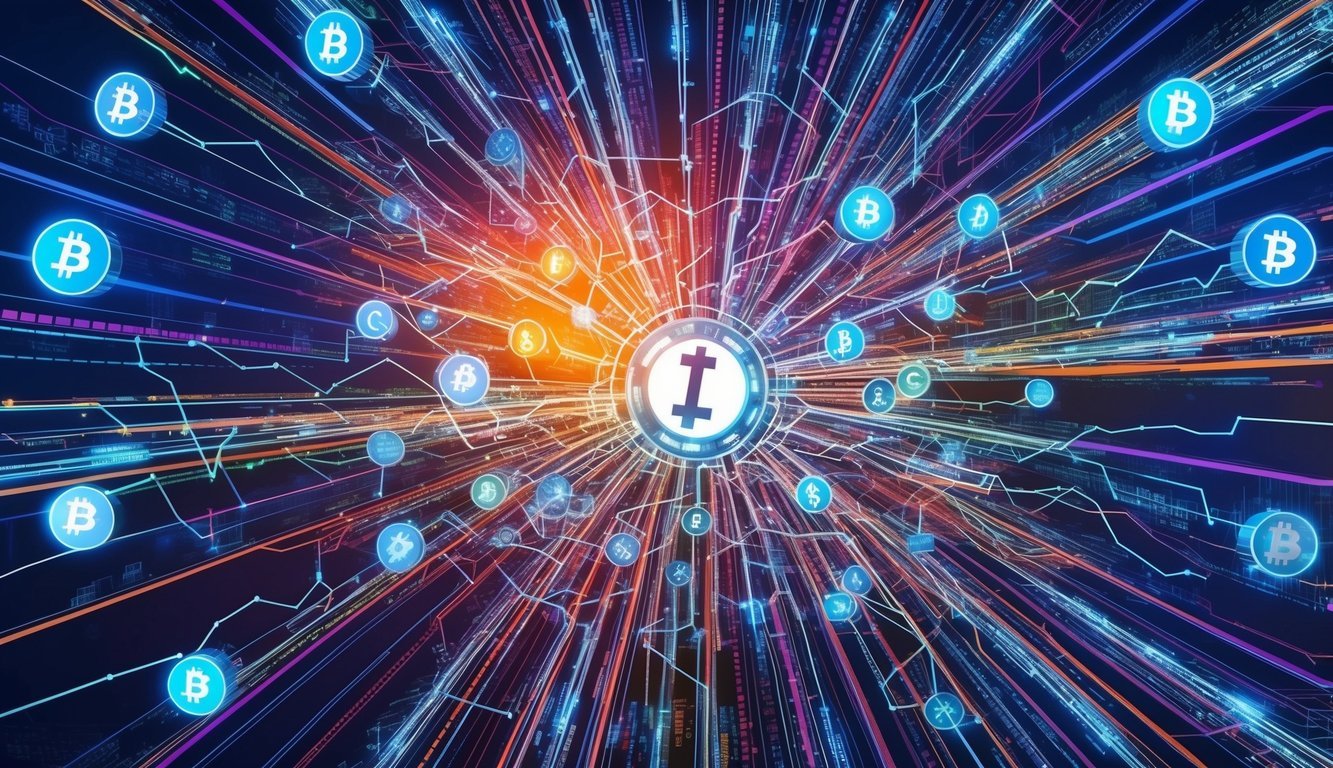ICON is a cool blockchain project that’s all about connecting different blockchains. It uses its own cryptocurrency called ICX to make this happen. ICX is the token that powers and governs the ICON network. This means you can use ICX for things like paying fees, lending and borrowing on decentralized finance (DeFi) platforms, and sending money to other people.

The ICON network is pretty neat because it’s trying to solve a big problem in the crypto world – how to get different blockchains to talk to each other. It’s like building bridges between islands. With ICON, you can potentially move your crypto assets between different blockchains without too much hassle.
ICX isn’t just for moving money around, though. It’s also used in a bunch of DeFi protocols on the ICON network, like Balanced and OMM. These platforms let you do all sorts of financial stuff without needing a bank. Plus, if you hold ICX, you can have a say in how the network is run. It’s like being a shareholder in a decentralized company.
Understanding ICON and the ICX Token
ICON aims to connect different blockchain networks. Its native token ICX plays a key role in how the system works. The ICON blockchain is designed to facilitate interoperability among diverse blockchain ecosystems, allowing them to communicate and exchange information seamlessly. As a result, ICX not only serves as a means of transaction within the network but also empowers users to participate in governance and staking activities. This innovative approach raises the question, what is the ICON blockchain, and how does it strive to transform the way different digital communities interact with each other?
What Is ICON?
ICON is a blockchain platform that links various networks. It lets different blockchains talk to each other. This is helpful because many blockchains can’t easily share info.
ICON uses something called a loopchain. This tech helps blockchains connect without losing their own special features. The ICON network has its own blockchain too.
You can think of ICON as a big connector. It brings together things like banks, schools, and even governments on one system.
How Does the ICX Token Function?
ICX is the main token used on the ICON network. You need it to do stuff on ICON’s blockchain. It’s like the fuel that keeps everything running.
Here’s what ICX does:
- Pays for transactions
- Helps run smart contracts
- Lets you vote on network changes
ICX started as an ERC-20 token on Ethereum. But now it runs on ICON’s own blockchain. You can use ICX to send money or pay for services on the network.
The ICON Foundation oversees the project. They make sure ICX works right and the network stays safe.
Key Features of ICON
ICON offers a range of cool features that make it stand out in the blockchain world. You’ll find it’s all about connecting different blockchains, letting users have a say, and providing a place for exciting financial apps.
Interoperability and the BTP
ICON’s Blockchain Transmission Protocol (BTP) is a game-changer. It lets different blockchains talk to each other without needing to trust a middleman. This means you can move your stuff between blockchains easily.
BTP works with smart contracts across chains. You can use apps on one blockchain that connect to apps on another. It’s like having a universal remote for all your blockchain needs.
This tech opens up a world of possibilities. You could trade tokens from different chains or use services across multiple networks. It’s making the blockchain world more connected and user-friendly.
Governance and Staking
ICON lets you have a say in how things run. You can stake your ICX tokens to vote on important decisions. It’s like being a shareholder in the network.
When you stake ICX, you earn rewards. The more you stake, the more you can potentially earn. It’s a way to grow your holdings while helping secure the network.
ICON uses a system called Delegated Proof of Stake (DPoS). You pick validators to represent you. These validators confirm transactions and keep the network running smoothly.
DeFi Ecosystem and dApps
ICON has a growing world of decentralized finance (DeFi) apps. These let you do all sorts of cool stuff with your crypto.
You can lend your tokens, borrow against them, or provide liquidity to earn fees. There are decentralized exchanges where you can trade tokens without a middleman.
Some popular DeFi apps on ICON include Balanced, OMM, and Optimus. Each offers different ways to use your ICX tokens and earn rewards.
ICON also supports other types of dApps. You could use a decentralized identity service or play blockchain games. The options keep growing as more developers build on the platform.
ICON’s Defi and Dapp Ecosystem
ICON has a growing ecosystem of decentralized finance (DeFi) protocols and apps. You’ll find lending platforms, stablecoin options, and more. Let’s look at some key parts of ICON’s DeFi world and popular dApps.
Financial Protocols on ICON
ICON offers several DeFi options. Balanced is a big one. It lets you use ICX as collateral to mint bnUSD, a stablecoin. You can also trade tokens there.
Another key player is OMM (Omm). It’s a lending platform where you can borrow or lend crypto. The $OMM token powers it.
Optimus is a yield optimizer. It helps you earn more from your crypto by auto-compounding your returns.
ICON also has sICX. It’s a staked version of ICX that you can use in DeFi without unstaking your ICX.
Popular dApps in the ICON Network
Beyond DeFi, ICON has other cool apps. Zzeung is one to watch. It’s a digital ID system that’s gaining traction.
BRRR is an interesting one. It’s a meme coin, but with some unique features. It’s tied to the US money supply in a quirky way.
For trading, ICON has AMM-style DEXes. These let you swap tokens easily, like on other blockchains.
Trading and the Economics of ICX

ICX is the native token of the ICON network. It’s used for transactions, staking, and governance. Let’s look at how to trade and store ICX, as well as its market data and tokenomics.
How to Trade and Store ICX
You can trade ICX on centralized exchanges like Binance. Some decentralized exchanges also offer ICX trading pairs. When buying or selling, watch out for trading fees.
To store your ICX, you have a few options. You can use ICON’s official wallet, ICONex, or MyIconWallet. These let you keep your tokens secure and stake them to earn rewards.
If you want to use ICX on the ICON network, you’ll need to pay transaction fees. These fees are usually small and help keep the network running smoothly.
ICX Tokenomics and Market Data
ICX has a max supply of 800,460,000 tokens. The circulating supply changes as tokens are burned or new ones are created through rewards.
The ICX price has seen ups and downs since its launch. Its all-time high was over $12 in 2018, but it’s been much lower since then. The market cap varies based on the current price and circulating supply.
You can stake ICX to become a validator or delegate to one. This helps secure the network and earns you daily ICX rewards. It’s a way to grow your holdings while supporting the ICON ecosystem.
ICX also works as a peer-to-peer currency. You can send it directly to others without a middleman, making it useful for quick and cheap transfers.
Frequently Asked Questions

ICX, the native token of the ICON blockchain, has many uses and aspects to understand. Let’s explore some common questions about ICX and the ICON network.
How can you predict the future price of ICX coin?
Predicting crypto prices is tricky. You can look at market trends, project developments, and overall crypto sentiment. But remember, prices are very volatile.
Keep an eye on ICON’s partnerships and tech upgrades. These can impact ICX’s value. Still, always do your own research and be ready for surprises.
What can ICX coins be used for?
ICX has several uses on the ICON network. You can use it to pay for transaction fees on the blockchain. It’s also used in ICON’s DeFi protocols like Balanced and OMM.
You can stake ICX to earn rewards and participate in network governance. Some people trade ICX on crypto exchanges too.
Where can I find the latest news and updates on ICX?
The ICON Community website is a great place to start. It has lots of info about ICON and ICX.
You can also check ICON’s official social media accounts. Reddit, Twitter, and Telegram often have fresh updates. Crypto news sites sometimes cover big ICON developments too.
What are the steps to mine ICX, if possible?
You can’t mine ICX in the traditional sense. ICON uses a delegated proof-of-stake (DPoS) system, not proof-of-work like Bitcoin.
Instead of mining, you can stake your ICX. This helps secure the network. You can become a validator or delegate your ICX to existing validators to earn rewards.
How do ICX wallets work?
ICX wallets let you store, send, and receive ICX tokens. Some popular ones are ICONex and Hana.
These wallets give you a unique address for transactions. They also let you stake ICX and interact with ICON dApps. Always keep your wallet’s private keys safe!
Can you explain the Icon Network?
ICON is a blockchain platform that aims to connect different blockchains. It uses something called the Blockchain Transmission Protocol (BTP).
The network lets you make smart contracts and build decentralized apps. It’s designed to be fast and scalable. ICON focuses on real-world use cases, especially in South Korea.




